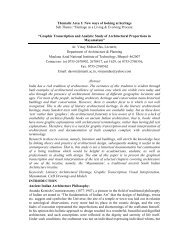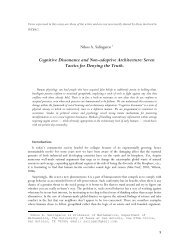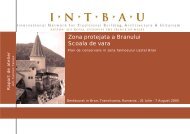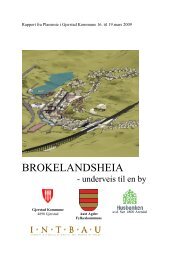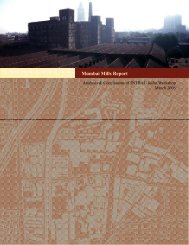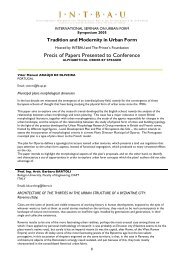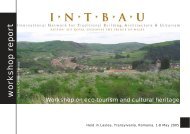S. Dalvi - Intbau
S. Dalvi - Intbau
S. Dalvi - Intbau
You also want an ePaper? Increase the reach of your titles
YUMPU automatically turns print PDFs into web optimized ePapers that Google loves.
Figure 9. Synagogues in Nandgoan, Panvel and RevdandaBetween 1840 and 1896, the Bene Israelis established 12 synagogues all over the Konkan, fromBombay to Revdanda. Few of these are extant and in use today. However, they too display adomestic scale like other sacred spaces in the Konkan. These synagogues are generic examplesof the non-monumental, community built, Konkan style place of worship, in timber constructionreflecting the unique generic pattern of building irrespective of religious affiliations. Built intimber on Brick or laterite masonry, these ‘masheeds’ are identifiable as Jewish only in theaccoutrements of their interiors with the Teba, the Hechal and the Tamid.The Beth-El Synagogue was built in 1849 on Panvel’s main street. It is well maintained and stillin active use today with several faithful visiting it from the region and even abroad. Far less welllooked after is the Jewish Burial Ground in Panvel occupying a small plot with mainly neglectedgraves. The presence of this burial ground is an indication of the presence and the socialsignificance of the members of the Jewish community in Panvel in the 19 th and the first half ofthe 20 th century. Many tombstones and cenotaphs bear inscriptions in three languages, Hebrew,English and Marathi simultaneously. A few older looking tombstones however bear inscriptionsonly in Hebrew. The names suggest that the Jewish people here had adopted Marathi surnames,like ‘Bension Solomon Bhoparkar’ or ‘Sasoon M. Khandalkar’. There is a significant epitaph inMarathi on a tombstone addressed “Dear Husband…. 4 ” In a poetic vein, the wife compares herhusband with ‘Ek-vachani Ram’ and ‘Gangajal’ and seeks God’s blessing for the same husbandfor next seven births. The inscription is signed by one Ruby-Bai Benjamin Chincholkar.The example of the Bene Israelis is replicated in the traditions of several other communities inthe region. The covert syncretism forms the binding glue that holds the community together. Thisis further embedded in the structures created by these communities, from abodes to places ofworship. Public life and the public aspect of buildings emerged over several generations ofunchanging existence and got concretized. Change was slow in coming, but as in the case ofPanvel and Uran, when it did, its was fast, and is irreversible.The palimpsest of Navi MumbaiNavi Mumbai came as an external project palimpsest on this extant situation. A project not of themaking of local inhabitants but that of Bombay, across the pond, as it were, that kick-started theaccretion of knowledge and urbanization, brought in change at a pace unimagined before andover thirty years engulfed two municipal councils older than Bombay. This is not to say that thechange has been negative. This part of the Konkan has been deprived of development ascompared to the other parts of Maharashtra and the project of New Bombay plugged the Konkan





